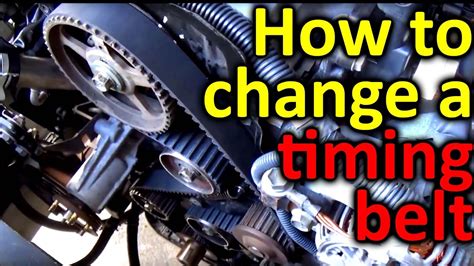Prolong Engine Life: Replace Your Timing Belt
Your car's engine is a complex machine, and its smooth operation relies on precisely timed movements of various components. One crucial element ensuring this precise timing is the timing belt. Ignoring its condition can lead to catastrophic engine failure, resulting in costly repairs or even a complete engine replacement. This article will explain the importance of timely timing belt replacement and guide you through understanding the process.
What is a Timing Belt?
A timing belt is a toothed rubber belt that synchronizes the crankshaft and camshaft(s) in your engine. The crankshaft rotates the pistons, while the camshaft controls the opening and closing of the valves. The timing belt ensures these components work together in perfect harmony. If the timing is off, even slightly, the pistons and valves can collide, causing severe engine damage.
Why Replace Your Timing Belt?
Timing belts are made of rubber and are susceptible to wear and tear. Over time, the rubber degrades, becoming brittle and prone to cracking. This degradation weakens the belt, increasing the risk of it snapping. A broken timing belt leads to immediate and potentially irreversible engine damage. The cost of repairing this damage far outweighs the cost of preventative timing belt replacement.
How Often Should I Replace My Timing Belt?
The recommended replacement interval for timing belts varies depending on the vehicle make, model, and engine type. Consult your vehicle's owner's manual for the manufacturer's specified recommendation. Generally, most manufacturers suggest replacement every 60,000 to 100,000 miles, or every 5 to 10 years, whichever comes first. Ignoring this recommendation significantly increases the risk of a catastrophic engine failure.
What Happens if My Timing Belt Breaks?
A broken timing belt is a serious issue. The most immediate consequence is a loss of engine power, as the pistons and valves are no longer synchronized. This can lead to bent valves, damaged pistons, and even a hole in the engine block – potentially requiring a complete engine rebuild or replacement. This is a costly repair, often exceeding thousands of dollars.
Signs You Need a Timing Belt Replacement
While a broken timing belt is obvious, several warning signs indicate it's time for a replacement:
- Visible cracks or fraying: Regularly inspect your timing belt (if accessible) for any signs of wear, cracking, or fraying.
- Unusual noises: A squealing or slapping noise from the engine compartment could indicate a worn or slipping timing belt.
- Engine misfires or hesitation: If your engine is misfiring, running roughly, or hesitating during acceleration, it could be due to timing issues.
- Mileage: If your vehicle has reached the recommended mileage interval for timing belt replacement, schedule the replacement regardless of apparent wear.
Can I Delay Timing Belt Replacement?
While tempting to delay replacement to save money, delaying can lead to far greater expenses in the long run. The cost of repairing a broken timing belt far surpasses the cost of preventive replacement. It's a preventative maintenance task that will save you money and protect your engine’s longevity.
The Timing Belt Replacement Process: What to Expect
Timing belt replacement is a complex procedure requiring specialized tools and expertise. It's best left to trained mechanics. The process usually involves removing various engine components to access the timing belt, carefully aligning the crankshaft and camshaft, installing the new belt, and reassembling everything.
How Much Does a Timing Belt Replacement Cost?
The cost varies significantly depending on the vehicle make, model, and labor costs in your area. Expect to pay anywhere from a few hundred dollars to potentially over a thousand dollars, depending on the complexity of the process. This expense is an investment in preventing costly engine damage.
Conclusion: Prioritize Preventative Maintenance
Regular preventative maintenance, including timely timing belt replacement, is crucial for extending the life of your engine and avoiding expensive repairs. By adhering to the manufacturer's recommended replacement schedule and being aware of warning signs, you can significantly reduce the risk of a broken timing belt and ensure your car runs smoothly for many years to come. Remember, a small investment in preventative maintenance can save you thousands in the long run.

